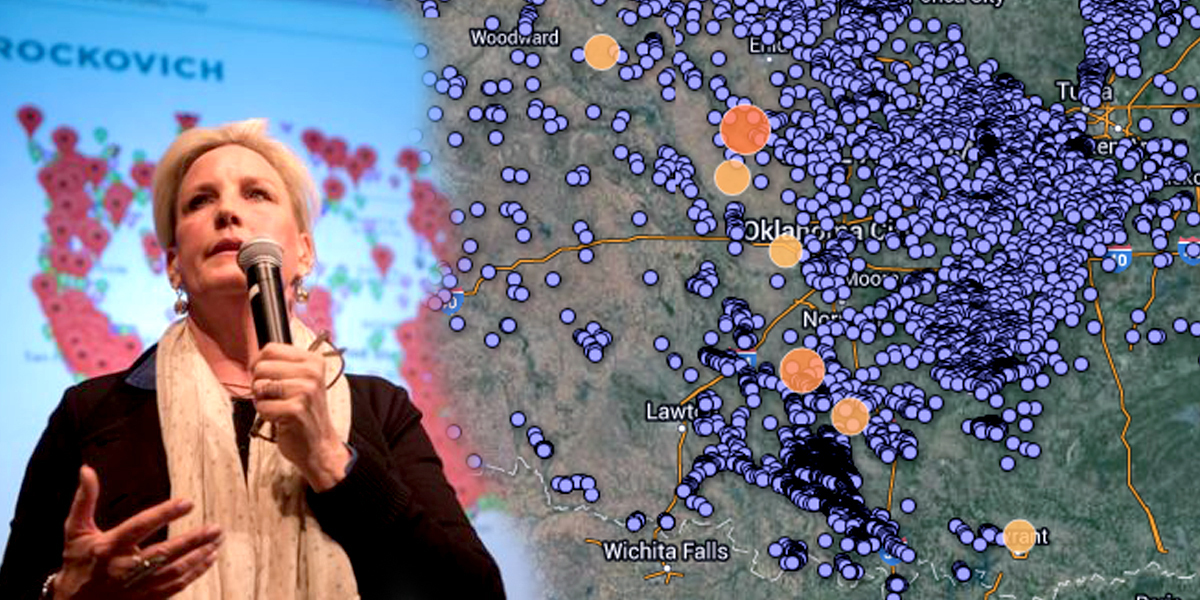
Erin Brockovich Meets With Oklahoma Residents Impacted by Human-Induced Earthquakes

As Pawnee, Oklahoma
still picks up the pieces from September’s record-breaking earthquake, environmental and consumer advocate Erin Brockovich and lawyers from Weitz & Luxenberg have traveled to the Sooner State to speak with residents about the alarming number of induced earthquakes affecting the area.
https://twitter.com/EcoWatch/status/773265817152684032
Meetings were held in Pawnee and Cushing on Thursday. The legal team also made plans to stop in Stillwater.
“The communities definitely [are] feeling frustrated and voiceless and helpless and not sure where to turn” Brockovich told KOCO 5 News at the Pawnee meeting.
For most, as News 9 pointed out, insurance companies are not covering repairs from the 5.8-magnitude earthquake in Pawnee.
The Midwestern state has seen a shocking
increase in magnitude-3 or larger earthquakes in recent years. Scientists have linked the seismic activity to the injection of large volumes of wastewater from oil and natural gas production into underground disposal wells. Fracking itself can cause earthquakes, although they are usually smaller and less frequently felt than earthquakes produced from underground injection.
The phenomenon has been dubbed as “man-made” or
induced earthquakes as they are triggered by human activities as opposed to “natural” seismicity.
In a Facebook post describing her visit to Oklahoma, Brockovich wrote:
“In 2009, Oklahoma recorded a maximum of 195 earthquakes in any given year, but by 2014, seismologists recorded over 5,000 earthquakes. The increase in earthquakes has been linked to the growing volume of wastewater injected deep into the ground by companies with fracking operations. The total volume of wastewater injected into ground wells has grown from 2 billion barrels in 2009 to over 12 billion barrels in 2014. This must stop!”
State regulators have implemented regulations to reduce the frequency of induced earthquakes, including the closing of wells and a disposal volume reduction plan.
This year, disposal well operators placed about 23 percent less wastewater into geological formations within the earthquake zone compared to the previous year, the
Associated Press reported. In all, Oklahoma Geological Survey data determined there were 623 quakes of 3.0 or greater in 2016, a 31 percent reduction from 2015.
At Thursday’s meeting in Cushing—the oil hub town that saw a
5.0 quake in November—Brockovich acknowledged that many Oklahomans rely on the oil and natural gas industry for jobs. At the same time, she believes that residents affected by the earthquakes need protection.
https://twitter.com/EcoWatch/status/795751492938592261
“We want you to have jobs. We understand that,” Brockovich said, according to
Tusla World. “But we also understand homes have been damaged. People are fearful. They don’t know who to trust.”
She added that the oil and gas industry should “do what’s right by your health and safety.”
“This isn’t a (political) party issue,” Brockovich said. “This is a right or wrong.”
New York-based firm Weitz & Luxenberg recently filed two class-action suits against oil and gas companies in response to severe damage caused by the powerful earthquakes in Cushing and Pawnee.
“Oklahomans continue to be put at risk by human-induced earthquakes, with hundreds of tremors—including the biggest in state history—rattling the area since my first town hall here last year,” Brockovich, a Weitz & Luxenberg consultant, said in a statement provided to EcoWatch. “This problem is clearly not going away, and it is critical that we show the businesses behind these quakes that we aren’t going away either.”
https://twitter.com/EcoWatch/status/702977724965642240
Chad Warmington, president of the Oklahoma Oil & Gas Association, responded to Brockovich’s appearance in a statement to Tulsa World.
“I expect what Ms. Brockovich will find on her business trip from California is that over the past year seismic events in Oklahoma have declined by 31 percent and that Oklahoma’s oil and natural gas industry has been quick to comply with state regulators’ directives on disposal well operations,” Warmington said. “Industry has also supplied its own data and millions of dollars in proprietary research to help all concerned parties better understand our state’s geology and fault lines.”

 233k
233k  41k
41k  Subscribe
Subscribe 